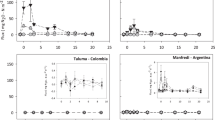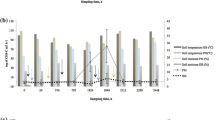Abstract
The study was designed to understand the emissions of ammonia (NH3) and carbon dioxide (CO2) from a single cattle urination event on a tropical grassland and underline the significance of the emissions in the context of huge animal population grazing on large pasture areas in some countries. Emissions of ammonia (NH3) and carbon dioxide (CO2) were monitored for three weeks from a tropical grassland (dominated by Cynodon dactylon Pers.) microcosm contaminated with cow and buffalo urine. The grassland microcosms were treated with urine (50 and 100 ml of each) only once and irrigated with water once every week. Ammonia was sampled by an automatic sampling system comprising of a vacuum pump, three-way stopcocks and rubber tubing and an impinger containing suitable absorbing solution (H2SO4), connected to the tubing suitably. The sampled gas, after sucked by the vacuum pump and absorbed in H2SO4, was allowed to enter the closed microcosm again maintaining internal pressure of the microcosm. Carbon dioxide was sampled by absorption in an alkali (NaOH) trap inside the microcosm. Both NH3 and CO2 emissions were highly variable temporally and there was no continuous increasing or decreasing emission trend with time. Respectively, 45 and 46% of total NH3-N were emitted within first 48 h from 50 and 100 ml cow urine application while the corresponding values for buffalo urine were 34 and 32%. Total NH3-N emissions, integrated for sampling days (i.e. 1, 2, 3, 4, 6, 15, 18 and 21st) were 11 and 6% in cow and 8 and 5% in buffalo urine, of the total-N added through 50 and 100 ml urine samples. Carbon dioxide emissions were standardized at 25 ∘C by using a suitable formula which were lower than actual emissions at actual soil temperature (> 25 ∘C). Carbon dioxide emission rates were classified on the basis of soil repiratory classification and classes ranged from moderately low soil activity up to unusually high soil activity, the latter observed only on very few sampling days. Grasses in the microcosm had shown appreciable growth after urine application. Although variable and somewhat unpredictable, emissions were appreciable and that too only from a patch of single urination, indicating to the huge magnitude of total emissions under the scenario of thousands of cattle grazing on hundreds of acres of grasslands in a tropical country.
Similar content being viewed by others
References
Aarnink, A. J. A., Hoeksma, P. and van Ouwerkerk, E. N. J.: 1993, ‘Factors affecting ammonia concentrationin slurry from fattening pigs’, in: M. W. A. Verstegen, L. A. den Hartog, G. J. M. van Kempen and J. H. M.Metz (eds.), Proc. Congr. on Nitrogen Flow in Pig Production and Environmental Consequences, Pudoc, Wageningen, The Netherlands, pp. 413–420.
Afzal, M. and Adams, W. A.: 1992, ‘Heterogeneity of soil mineral nitrogen in pasture grazing by cattle' Soil Sci. Soc. Am. J. 56, 1160 –1166.
American Public Health Association (APHA): 1977, Methods of Air Sampling and Analysis(Ed. Katz.M.), APHA, Washington D.C., pp. 511–513.
American Public Health Association (APHA): 1985, Standard Methods of Analysis of Water andWastewater (16th ed), APHA, AWWA and WPCF, Washington D.C.
Anderson, J. P. E.: 1982, Soil respiration, in: A. L. Page, R. H. Miller and D. R. Keeney (eds.), Methods ofsoil Analysis, part 2-Chemical and Microbiological Properties, Madison, Wisconsin, American Society of Agronomy, Soil Science Society of America, Inc, pp. 831–871.
Bornemann, F.: 1920, ‘Kohlensaure und Pflaenwachstumn’. Mitt. Deut. Landwirt. Ges. 35, 693–695.
Canh, T. T.: 1998, ‘Ammonia emission from excreta of growing-finishing pigs as affected by dietarycomposition’, Ph.D. thesis. Agricultural Univ. Wageningen, The Netherlands.
Di, H. J. and Cameron, K. C.: 2002b, ‘Nitrate leaching and pasture production from different nitrogensources on a shallow stony soil under flood irrigated dairy pasture’, Aust. J. Soil Res. 40, 317–334.
Di, H. J. and Cameron, K. C.: 2000a, ‘Calculating nitrogen leaching losses and critical nitrogen applicat-ionrates in dairy pasture systems using a semi empirical model’, New Zealand J. Agril. Res. 43, 139–147.
Field, T. R. O., Theobald, P. W., Ball, P. R. and Clothier, B. E.: 1985, ‘Leaching losses of nitrate fromcattle urine applied to a lysimeter’ Proceedings of the Agronomy Society of New Zealand 15, 137–141.
Frank, D. A. and Zhang, Y.: 1997, ‘Ammonia volatilization from a seasonally and spatially variable grazedgrassland: Yellowstone National Park’, Biogeochemistry 36, 189–203
Gomez, A. K. and Gomez, A. A.: 1984, Statistical Procedures for Agricultural Research (2ndedition), John Wiley and Sons, New York, USA.
Haynes R. J. and Williams P. H.: 1993, Nutrient cycling and soil fertility in thegrazed pasture ecosystem’. Adv. Agron. 49, 171–173.
Holmes, W.: 1989, Grass: Its Production and Utilization. Hurley:The British Grassland Society, 306 p.
Intergovernmental Panel on Climate Change: 2001, Climate Change 2001: A ScientificBasis, Intergovernmental Panel on Climate Change. Houghton, J. T., Ding, Y., Griggs, D. J., Noguer, M., van de Linden, P. J., Dai, X., Johnson, C. A. and Maskell, K. (eds.), Cambridge University Press, Cambridge, UK.
Keeney, D. R. and Nelson, D. W.: 1982, Nitrogen–Inorganic forms, in: A. L. Page, R. H. Miller and D. R. Keeney(eds.), Methods of soil Analysis, part 2-Chemical and Microbiological Properties, Madison, Wisconsin, American Society of Agronomy, Soil Science Society of America, Inc, pp. 674–676.
Lantinga, E. A., Keuning, J. A., Groenwold, J. and Dennen, P. J. A. G.: 1987, ‘Distribution of excreted nitrogenby grazing cattle and its effects on sward quality, herbage production and utilization’, in H. G. van derMeer, R. J. Unwin, T. A. Van Dijk and G. C. Enink (eds.) Animal Manure on Grassland and Fodder Crops:Fertilizer or Waste?, Dordrecht: Martinus Nihhoff, pp. 103–117.
Leterme, P., Barre, C., Vertes, F.: 2003, ‘The fate of 15N from dairy cow urine under pasturereceiving different rates of N fertilizer’ Agronomie 23, 609–616.
McCulloch, R. B., Few, G. S., Murray, G. C. and Aneja, J. P.: 1998, ‘Analysis of ammonia, ammonium aerosols andacid gases in the atmosphere at a commercial hog farm in eastern North Carolina, USA’, Env. Poll. 102, 263–268.
Parkin, T. B., Doran, J. W. and Franco Vizcaini, E.: 1996, Field and Laboratory tests of soil respiration, in: J.W. Doran and A.J. Jones (eds.) Methods for Assessing soil quality, Soil Sci Soc Am Spec Publ., 49, SSSA, Madison, WI, USA, P231–246.
Peyraud, J. L. and Astigarraga, L.: 1998, ‘Review of the effect of nitrogen fertilization on the chemicalcomposition, intake, digestion and nutritive value of fresh herbage: consequences on animal nutrition and Nbalance’, Animal Feed Sci. Tech. 72, 235–259.
Schlesinger, W. H. and Hartley, A. E.:1992, ‘A global budget for atmospheric NH3’, Biogeochem. 15(3), 191–211.
Scholefield, D. and Fisher G. E. J.: 2000, Nutrient cycling in grazing systems. The principles and practiceof grazing, for profit and environmental gain, within temperate grassland systems. OccasionalSymposium No. 34 British Grassland Society.
Silva, R. G., Cameron, K. C., Di, H. J. and Hendry, T.: 1999, ‘A lysimeter study of the impact of cowurine, dairy shed effluent and nitrogen fertilizer on drainage water quality’, Aust. J. Soil Res. 37, 357–369.
Singh, D., Chhonkar, P. K. and Pandey, R. N.: 2000, Soil Plant Water Analysis. A Methods Manual, Indian Agricultural Research Institute (ICAR), New Delhi. India.
Singh, S. P., Satsangi, G. S., Khare, P., Lakhani, A., Kumari, K. M. and Srivastava, S. S.: 2001, ‘Multiphasemeasurement of atmospheric ammonia’, Chemosphere 3, 107–116.
Stotzky, G.: 1965, Microbial respiration. In: Methods of Soil analysis Part 2, C. A. Black et al. Eds., Agron.Monograph 9, ASA and SSSA, Amdison, WI, pp. 1550–1572.
Ueda, J., Takemoto, T., Kim, Y. P. and Sha, W.: 1999, ‘Behaviors of volatile inorganic components in urbanaerosols’, Atm. Env. 34, 356–361.
United States Department of Agriculture: 1999, Soil Quality Test Guide. Washington D.C., USA, pp. 52–54.
Vallis, I., Harper, L. A., Catchpoole, V. R. and Weier, K. L.:1982, ‘Volatilization of ammonia from urine patches ina subtropical pasture’, Aust. J. Agril. Res. 33(1), 97 – 107.
Van der Meer, H. G.: 1986, The relationship between inputs and outputs of nitrogen in intensive grasslandsystems, in: H. G. van der Meer, J. C. Ryden and G. C. Ennik (eds.) Nitrogen Fluxes in Intensive Grasslandsystems. (Developments in plant and soil sciences; 23). Dordrecht, Nijhoff, 113 p.
Van Vuuren, A. M. and Meijs, J. A. C.: 1987, Effects of herbage composition and supplement feeding in theexcretion of nitrogen in dung and urine by grazing dairy cows, in H. G. van der Meer, R. J. Unwin J. A.Dijk and G. C. Ennik (eds.), Animal Manure on Grassland and Fodder Crops. Fertilizer or Waste?Dordrecht: Martinus Nijhoff, pp. 17–25.
Walker, J. T., Aneja, V. P. and Dickey, D. A.:2000, ‘Atmospheric transport and wet deposition of ammonium inNorth Carolina’. Atm. Env. 34, 3407–3418.
Whitehead, D. C.:1995, Grassland Nitrogen. CAB International, Wallingford, UK, pp. 108–128.
Woods End Research: 1997, Guide to Soltiva Testing and Managing Your Soil, Woods End ResearchLaboratory, Inc., Mt. Vernon, ME.
Author information
Authors and Affiliations
Corresponding author
Rights and permissions
About this article
Cite this article
Majumdar, D., Patel, M., Drabar, R. et al. Short-term Emissions of Ammonia and Carbon Dioxide from Cattle Urine Contaminated Tropical Grassland Microcosm. Environ Monit Assess 122, 9–25 (2006). https://doi.org/10.1007/s10661-005-9160-y
Received:
Accepted:
Published:
Issue Date:
DOI: https://doi.org/10.1007/s10661-005-9160-y




